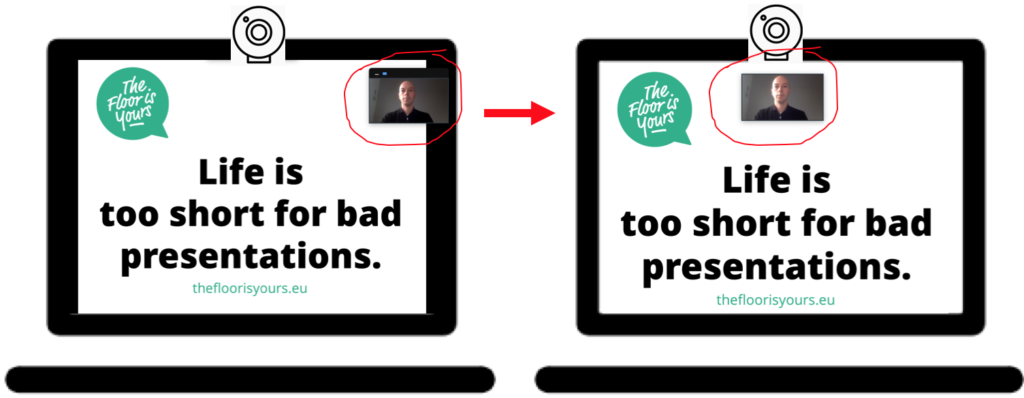Online presentations: how do you get started?
Currently, all meetings, classes and conferences have been suspended. Fortunately, there are plenty of online tools that allow us to continue to communicate with each other remotely.
But giving an online presentation is quite different from speaking to an actual audience. How do you get started? And how do you ensure that your message sticks and your audience remains with you until the end?
There are various forms of online presentation: with or without slides, with or without you in the picture, or with an audience that may or may not respond live. But the two consistent elements are these: your voice and your content.
What truly matters, is your story and how you can make it stick with your audience.
The tips we will share with you here focus on the content of your presentation and how to best convey your message. Because that is where things often go awry. Speakers are mainly concerned with the choice of software, and that may cause them to lose sight of the actual content. What truly matters, is your story and how you can make it stick with your audience. And we are happy to help you with this, with or without coronavirus.
What makes online presentation different?
First, your online audience gets distracted easier. One person may be on her laptop in bed, having breakfast, while the other is sharing the sofa with his toddler playing. What happens if things become boring? They may click to a news site to track the number of infections, or they quickly check the likes they got for their photo of the empty supermarket shelves on Instagram. You will need to step things up to hold people’s attention!
Second, you speak to a camera rather than a physical audience. You have to imagine that there is an audience in front of you, but you can not read on their faces whether they understand what you are saying or whether they find it interesting. The longer the presentation lasts, the more energy it will take to stay focussed. Therefore, you have to be even better prepared!
We are offering our workshops online. The software we use for this is Zoom.
Three golden rules
While we know that you have little time to prepare your online presentation, please do keep in mind the following rules. They will make or break your presentation.
- Have a plan. You need a well thought-out structure that guides your audience step by step through your story. Without a plan, you are lost. Now is not the time to just wing it.
- Engage until the end. Make your presentation exciting, use cliff hangers and regularly reward your audience for their attention, by giving them a concrete insight or, for instance, by telling your students what they really need to know.
- Keep it as short as possible. While a normal lesson may be 60 minutes, you won’t last that long online. Focus on the essentials. Can you tell your story in ten minutes? Then do that and refer, for example, to additional text that they can download with background information. Or divide your lesson into shorter segments of just a few minutes each, which you can then post online separately.
Getting started in 4 steps
Step 1: choose your goal.
What do you want to achieve with your presentation and who is it aimed at? Suppose you are preparing an online presentation on the subject of anxiety for students. Do you want them to remember the definition and the ten forms of anxiety? Or would you like them to learn how to recognize signs of anxiety in themselves and be given specific tools to do something about it?
Depending on your objective, your presentation should look very different. Start by choosing a clear goal that is relevant to your target audience. You may have multiple goals, but choose one main goal. And: drop the things that do not strictly fit that main purpose. They should not be included in your online lesson.
Step 2: take a blank sheet of paper and work out your structure.
Your presentation should consist of three sections: an intro, a middle section, and a conclusion.
The intro serves to engage your audience and to briefly outline what you will be sharing with them. Demonstrate what the underlying problem or challenge is, what solution you have to offer, and why this is relevant.
Take the anxiety example:
“This is Nico, student of the first Bachelor of Law. He has trouble sleeping at night because he’s constantly brooding over things. His girlfriend just broke up with him, he’s broke, and he is afraid he will fail his school exams. He doesn’t know what to do. X% of all students suffer from anxiety. But did you know that thanks to a couple of simple techniques you can tackle this yourself? Let me teach you these techniques in the next ten minutes.”
After this intro you can briefly introduce yourself and switch to the middle section. Preferably choose three points that you want to delve deeper into.
For example, 1) Why is anxiety such an issue? 2) Three techniques to get started yourself 3) How do you build a routine?
Share this structure with your audience so they know what will follow and come back to it from time to time.
At the end, you repeat your main message and why it is relevant to your audience. Ideally, you would circle back to the attention grabber you started with. For example, you could conclude by saying that Nico got rid of his sleeping problems thanks to those techniques.
Step 3: keep it interesting.
Now that you have your structure, how do you ensure that your audience remains with you to the end?
- Look for wow factors, something we discussed in a previous article. Try to start every new step with a wow factor.
- After each intermediate step, summarize what you did and what the next step will be. This way your audience has a chance to catch up, even if your message is complex or if they were distracted for a moment.
- Ask regular questions, such as “Do you recognize this?”, “How would you solve this?” Or “How can we put this into practice?”
Step 4: practice!
Because presenting online is very different from standing in front of a group, it is important to practice beforehand. Record your presentation online and pay attention to the following elements:
- Make eye contact by looking into your camera. This is the only way your audience will feel that you are addressing them. You probably have a tendency to look at yourself in the small screen during recording, but then you lose eye contact with your audience. That is why it is better to move that small screen to just below where your camera is on your laptop, encouraging you to always look in the direction of your camera.

- Use your facial muscles. Did you know you have about forty of these muscles? The more expressive you are, the more you will captivate and engage your audience to continue listening. Also, an occasional smile works wonders.
- And pay attention to your surroundings. It is best to opt for a sober environment, without too many distracting elements behind you, such as a bulging bookcase. Are your children at home at the time of your recording? Then ask them not to disturb you to avoid hilarious scenes.
We offer you a free private 30-minute Skype or Zoom session
Because life is too short for bad online presentations, we are happy to provide you with feedback.
- Are you looking for ways to clearly share a complex message?
- Are you having trouble finding a suitable wow factor?
- Does that webcam in front of you stress you out?
Share with us your question and we’ll schedule a free private 30-minute Skype or Zoom session to help you solve your problem and improve your online presentation.
(Offer valid until April 6, 2020)
